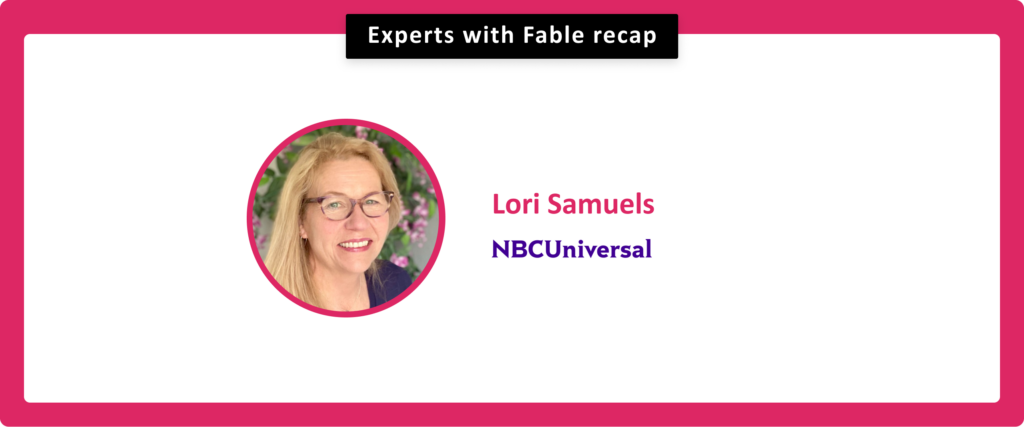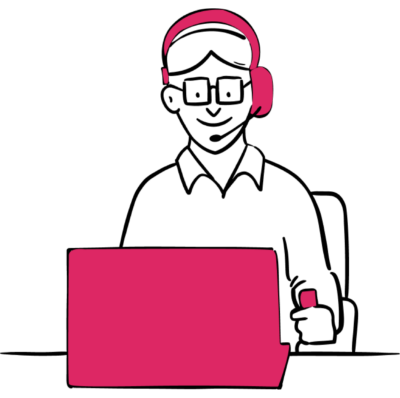
Experts with Fable recap
How NBCUniversal builds cultural maturity in accessibility
Experts with Fable is an ongoing webinar series where UX designers, researchers, product managers, engineers and accessibility professionals from leading companies discuss their digital accessibility projects, lessons, and strategies. To stay in the loop about future Experts with Fable, follow us on LinkedIn or sign up for our newsletter.
In a conversation with Accessibility Evangelist Samuel Proulx, Senior Director of Accessibility at NBCUniversal Lori Samuels discussed:
- How organizations can level up their accessibility maturity and make progress, whether you’re just getting started or have initiatives in place.
- NBCUniversal’s approach to nurturing empathy and accountability across different roles.
- The benefit of a blended practice that satisfies accessibility standards and prioritizes usability.
Organizational change management
“I’ve come to think of [accessibility] as changing habits at scale.” – Lori Samuels
Making progress in accessibility is about getting a lot of people to behave a little differently. They’ll have to adopt new behaviours, pick up new practices, and learn new skills. Accessibility has to be organized across multiple roles, and the people in those roles need to be led towards goals. That requires a lot of change for a lot of people, especially in a large organization.
Accessibility leaders, champions and practitioners don’t have the authority or power to magically make everything accessible. We need to influence organizations to drive change.
Helping people unlearn
There is often initial resistance to working on accessibility. It can be helpful to approach that resistance with curiosity instead of judgement. People may have had negative experiences, feel stretched for time, or may not understand how people with disabilities interact with the digital world.
You can help by setting context. Every time you talk about accessibility, start by talking about disability to centre the work that you do. Help people to understand that accessibility is about people with disabilities having good experiences, like anyone else.
“I think the ultimate goal to chase for a product team is to make sure that people with disabilities can use and enjoy your product and content in the way that it was intended.” – Lori Samuels
How to measure accessibility progress
Look to multiple data sources to measure your progress. If we want to anchor on people with disabilities having good experiences, you can conduct user testing to get that data. You’ll uncover issues in the experience, and you can administer a survey to get an Accessible Usability Scale (AUS) score to help you quantify the experience. Automated testing can help identify issues in code, and when combined with user testing you can start to set effective benchmarks for your products. Whatever data you decide to leverage, start with a small and realistic scope for changes.
“If you aren’t engaging people with disabilities in your process… you can’t really tell if you’re succeeding or not.” – Lori Samuels
Customize the approach to the culture
It’s important to figure out what motivates your organization. Is it a competitive environment? Are they really into customer experience? Does your customer base skew to an older demographic? Accessibility can fit into all of these approaches. Lori has the following quote in her email signature as a reminder:
Accessibility is not a problem to be solved, it’s a culture to be built. – Sheri Byrne Haber
Using culture as a foundation, you can start to build habits and break down the work. For example, add accessibility to user stories, or start tackling a few barriers, aiming for keyboard accessibility and good color contrast.
Building relationships and empathy
“I want accessibility to be a good experience for the people in this company. That’s my goal. I want it to be something that’s fun and interesting and makes them feel like they’re getting better at their craft.” – Lori Samuels
It’s important to find people who have passion for accessibility and build a circle of support. Designers can be great early allies for accessibility because they understand empathy and tend to be naturally user-centric.
The best leaders are also empathetic. You can often connect them to the importance of accessibility by providing them with qualitative findings that they can work with, like video clips of people with disabilities interacting with your products. If you make people feel something, that can motivate the change needed for accessibility to move forward.

